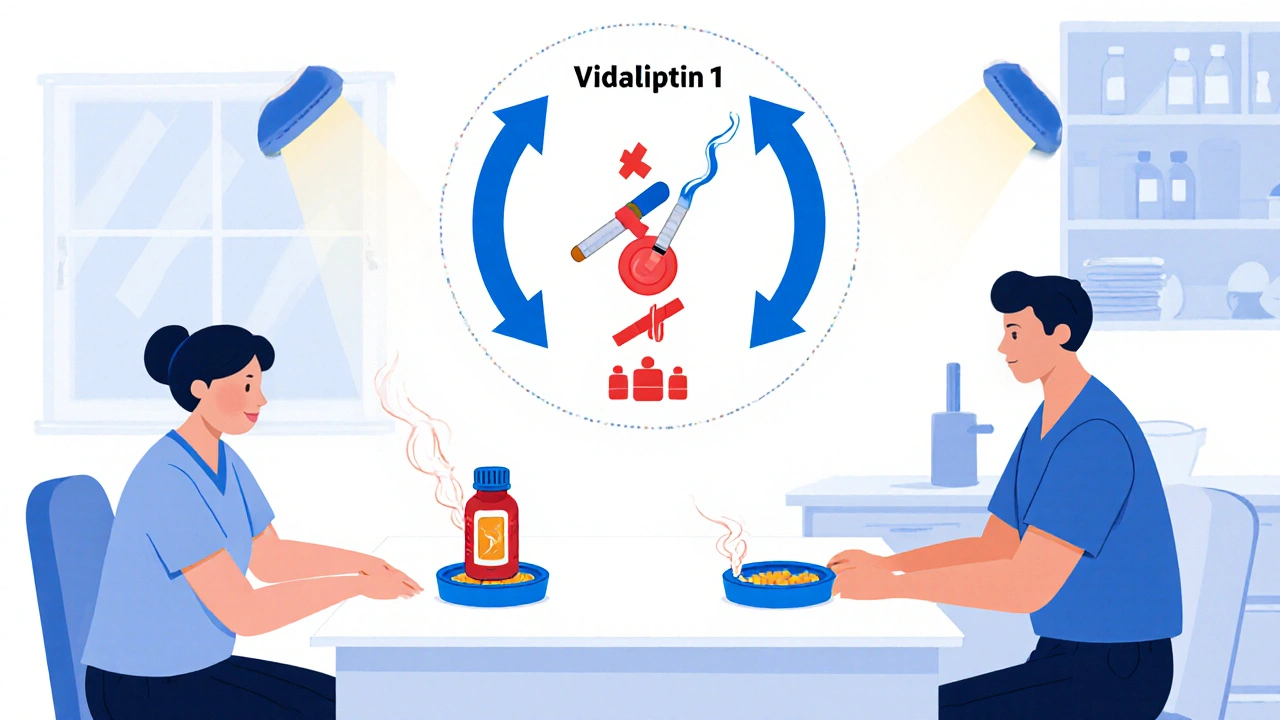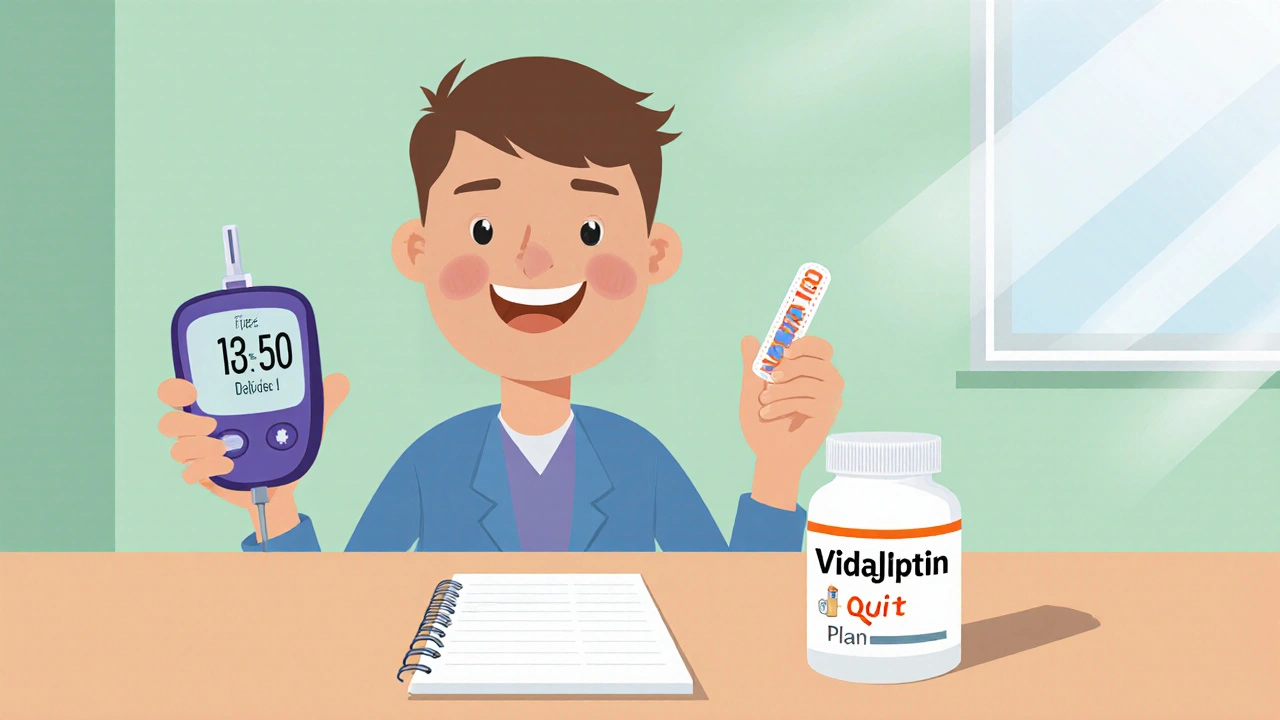Quitting smoking feels like climbing a mountain while juggling a handful of pills. What if one of those pills-already prescribed for diabetes-could give you a nudge downhill? vidagliptin smoking cessation is a question many patients ask, and the answer isn’t as simple as “yes” or “no.” Below we break down what vidagliptin does, how it might intersect with nicotine cravings, and what the science says today.
What Is Vidagliptin?
Vidagliptin is a oral medication classified as a DPP-4 inhibitor. It works by blocking the enzyme dipeptidyl peptidase‑4, which in turn raises levels of incretin hormones that help regulate blood sugar after meals. In the U.S., the FDA approved vidagliptin for adults with type 2 diabetes in 2023, and it’s often prescribed when metformin alone isn’t enough.
Understanding Smoking Cessation
Smoking cessation refers to the process of quitting tobacco use. It combines behavioral strategies, medications, and sometimes counseling to break nicotine addiction. Nicotine addiction triggers dopamine release, creating a powerful reward loop that makes quitting feel like pulling teeth. Classic cessation tools include nicotine replacement therapy (NRT), bupropion, and varenicline, each targeting different parts of that loop.
Where Vidagliptin and Smoking Meet
At first glance, a diabetes drug and a nicotine habit seem unrelated. The link lies in the role of incretin hormones-particularly GLP‑1 (glucagon‑like peptide‑1). GLP‑1 not only boosts insulin secretion but also slows gastric emptying and reduces appetite. Some researchers think higher GLP‑1 levels can blunt reward pathways, potentially lowering cravings for nicotine.
In animal studies, DPP‑4 inhibitors like vidagliptin have modestly reduced self‑administration of nicotine, hinting at a crossover effect. Human data, however, are still thin.

What the Clinical Evidence Shows
Only a handful of clinical trials have looked directly at vidagliptin for smoking cessation. A small 2024 pilot in Japan enrolled 60 adults with type 2 diabetes who smoked at least 10 cigarettes a day. Participants kept their usual diabetes regimen but added vidagliptin or a placebo. After 12 weeks, 30% of the vidagliptin group reported a ≥50% reduction in cigarettes, versus 12% on placebo. The difference was statistically significant, but the sample size was tiny.
Observational studies provide mixed signals. One 2025 database analysis of 15,000 diabetics found that those on DPP‑4 inhibitors, including vidagliptin, were slightly more likely to quit smoking within a year compared to those on sulfonylureas. Yet confounding factors-like more frequent doctor visits-could explain the trend.
How to Use Vidagliptin If You Want to Quit
- Talk to your endocrinologist or primary care doctor first. Vidagliptin is prescription‑only and should be taken exactly as directed.
- Typical dose is 100 mg once daily, taken with or without food.
- Combine the medication with a proven cessation method-NRT patches, a quit‑line, or behavioral therapy-rather than relying on vidagliptin alone.
- Track your smoking patterns. A simple diary or a mobile app helps you see whether cravings dip after a few weeks on the drug.
- Schedule follow‑up labs every 3‑4 months to monitor kidney function and blood glucose, as DPP‑4 inhibitors are cleared renally.
Safety and Side‑Effect Profile
Vidagliptin is generally well‑tolerated. The most common side effects include mild stomach upset, headache, and upper‑respiratory infections. Rarely, users report pancreatitis-a serious condition that needs immediate medical attention.
Because the drug can affect blood sugar, watch for hypoglycemia if you’re also on insulin or sulfonylureas. Adjusting dosages should always be done under physician guidance.

Alternatives and Combination Approaches
If vidagliptin isn’t an option, plenty of other paths exist. Below is a quick comparison of the most common tools.
| Approach | Mechanism | Typical Success Rate (12‑mo) | Common Side Effects |
|---|---|---|---|
| Vidagliptin (off‑label) | DPP‑4 inhibition ↔ ↑GLP‑1 ↔ reduced reward signaling | ~30% in small trials | Headache, GI upset, rare pancreatitis |
| Nicotine Replacement Therapy | Provides low‑dose nicotine to ease withdrawal | ~15‑25% | Skin irritation (patch), throat irritation (gum) |
| Bupropion | Dopamine‑norepinephrine reuptake inhibitor | ~30% | Insomnia, dry mouth, rare seizures |
| Varenicline | Partial nicotine receptor agonist | ~35‑40% | Nausea, vivid dreams, mood changes |
| Behavioral Therapy | Counseling & coping strategies | ~20‑30% (when solo) | None |
Practical Checklist Before Starting Vidagliptin for Cessation
- Confirm you have type 2 diabetes and are already a candidate for DPP‑4 inhibition.
- Discuss off‑label use with your prescriber; document the plan.
- Set a quit date and choose a supporting method (NRT, counseling, app).
- Order baseline labs: HbA1c, serum creatinine, liver enzymes.
- Schedule weekly brief check‑ins for the first month to monitor cravings and side effects.
- Keep a log of cigarettes smoked and any reduction trends.
- Plan a follow‑up visit at 3 months to reassess diabetes control and cessation progress.
Bottom Line
Vidagliptin isn’t a magic bullet for quitting smoking, but early data suggest it could give a modest edge when paired with proven cessation tools. If you’re already on a DPP‑4 inhibitor for diabetes, ask your doctor whether a trial makes sense for you. Remember, the most reliable way to quit is a combination of medication, behavior change, and support-not a single pill.
Can vidagliptin be prescribed solely for smoking cessation?
No. Vidagliptin is approved only for type 2 diabetes. Using it to quit smoking is considered off‑label and should only be done under close medical supervision.
Does vidagliptin reduce nicotine cravings?
Small studies hint at a modest reduction in cravings, likely because higher GLP‑1 levels can dampen reward pathways. The effect isn’t strong enough to replace dedicated cessation medications.
Are there any interactions between vidagliptin and nicotine replacement products?
No direct drug‑drug interaction is known. However, both can affect blood sugar, so monitoring glucose is advised when using NRT patches or gums.
What side effects should I watch for?
Common: mild stomach upset, headache. Rare but serious: pancreatitis or severe allergic reaction. If you notice persistent abdominal pain, seek medical care immediately.
How long should I stay on vidagliptin if it helps me quit?
Continue it as long as you need diabetes control. If you achieve both blood‑sugar targets and sustained smoking abstinence, discuss tapering or switching with your doctor.



Ah, the battle against nicotine is nothing short of an epic saga, a tempest that rages through the very fibers of our being, and now a humble DPP‑4 inhibitor steps onto the stage like an unexpected hero; vidagliptin, the unsung ally of the diabetic warrior, might just be the secret weapon we never imagined. The clinical world has whispered about its modest ability to dim the dopamine fireworks that keep smokers chained, and the saga continues with each pilot study that teeters on the edge of hope. In the 2024 Japanese pilot, a third of the participants on vidagliptin reported a dramatic cut in cigarettes, a statistic that sings like a chorus of triumph amidst the clamor of failure rates. Yet the sample was small, the shadows of confounding variables loomed large, and the scientific community remains cautious, polishing the data like a fragile crystal. The mechanistic bridge lies in GLP‑1 elevation, a hormone that not only tames appetite but may also mute the reward circuits that nicotine hijacks. Animal models have shown a faint glimmer of reduced self‑administration, a flicker that fuels optimism but also demands rigorous human validation. The safety profile is reassuring for most, with only mild GI upset and occasional headache, though the specter of pancreatitis hovers as a reminder of vigilance. For those already walking the tightrope of diabetes management, adding vidagliptin could be a double‑edged sword, potentially granting a modest edge in the cessation war while demanding careful glucose monitoring. Combining this off‑label use with established aids-patches, counseling, quit‑lines-creates a multi‑pronged assault that feels more like a strategic campaign than a solo crusade. Ultimately, the drug is no silver bullet, but in the grand tapestry of cessation tools it threads a subtle, hopeful hue. The journey, like any ascent, requires perseverance, support, and a willingness to experiment under medical guidance. As the data accumulates, perhaps vidagliptin will earn a permanent place in the arsenal, standing beside varenicline and bupropion as a quiet but steadfast companion. Until then, the story remains unwritten, awaiting the next chapter of rigorous trials and patient experiences. In the theater of quitting, every prop counts, and vidagliptin may just be the understudy ready to step into the spotlight when the curtain rises. Let us watch, let us study, and let us hope that this modest molecule can tip the scales toward a smoke‑free horizon.
Integrating vidagliptin into a cessation protocol leverages synergistic pharmacodynamics by augmenting GLP‑1 mediated reward attenuation while maintaining glycemic homeostasis. The off‑label application aligns with evidence‑based multimodal frameworks that prioritize nicotine receptor desensitization and neurobehavioral conditioning. Patient adherence improves when digital health analytics track craving indices alongside HbA1c trends, creating a closed‑loop feedback system. This strategy maximizes therapeutic index without introducing additional drug‑drug interaction risk.
Look, if you’re still lighting up after your doctor prescribed a diabetes pill, you’re basically treating the problem like a bad habit instead of a medical crisis. It’s selfish to think a cheap shortcut will absolve you of the damage you’re doing to yourself and everyone around you.
When we contemplate the intertwining of chemistry and willpower, we glimpse the delicate dance of free will and molecular influence. Vidagliptin, a modest DPP‑4 inhibitor, becomes a metaphor for the subtle forces that nudge us toward change. It reminds us that even the smallest biochemical shift can ripple through the landscape of habit, echoing the ancient Stoic notion that virtue arises from aligning internal states with external actions. In practice, pairing this drug with mindful cessation techniques could cultivate a harmonious equilibrium, where the mind and body co‑author the narrative of a smoke‑free life :)